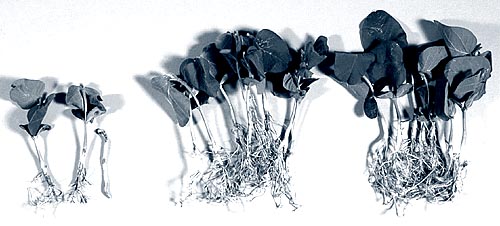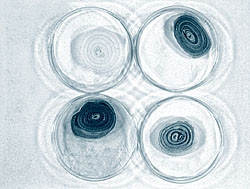
Edition 9 - June, 2001
 Edition 9 - June, 2001 |
Burkholderia cepacia: Pandora’s box redefined |
B. cepacia is an extremely versatile organism that is truly both friend and foe to humans. It is a genuinely ubiquitous organism with its niches being soil, water, animals, plants and humans. Although originally identified as a plant pathogen, it is now recognised as a most useful organism for plant protection and plant-growth promotion. However, it has simultaneously become notorious as a naturally multi-resistant and life-threatening pathogen in immune suppressed hosts such as cystic fibrosis (CF) patients and patients with chronic granulomatous disease.
Before the early 1980s, reports of human infections
caused by B. cepacia were sporadic and generally restricted to hospitalised
patients exposed to contaminated disinfectant and anaesthetic solutions.
A rising incidence, particularly in patients with CF, was
noted in the early 1980s. Cystic fibrosis is the most common lethal inherited
disease of Caucasian populations with pulmonary infections being the major cause
of morbidity and mortality. Infection or colonisation by B. cepacia leads to
different outcomes in different patients. However, overall, pulmonary
colonisation reduces survival by 50% and about one third to a half of the
patients succumb to "cepacia syndrome", a rapidly fatal necrotising
pneumonia. During the 1980s and 1990s, several major outbreaks of B. cepacia
infections resulted in numerous deaths in CF populations worldwide. More
recently, serious outbreaks with fatalities have occurred in non-CF patients
being treated in intensive care units in Europe and North America.
Care and concern for the environment are leading
scientists to develop biological alternatives to the present chemical strategy
in the agro-industry and to reduce environmental chemical pollution. Control of
plant diseases, insects and nematodes by bacteria and fungi has been proposed as
an alternative or supplement to chemical pesticides. Roots and rhizospheres of
various crops such as corn, maize, rice, pea, sunflower, and radish can be
colonised by B. cepacia-like organisms, some of which produce a variety of
antimicrobial compounds that are active against soil pathogens. Using these B.
cepacia-like organisms as seed inoculants or root dips can increase crop yields
significantly. Moreover, when there are no soil pathogens, a significant growth
promoting effect has been reported.
The exceptional
nutritional potential of some B. cepacia strains is being used in the
bioremediation of hazardous waste sites and effluents. Carcinogenic or toxic
products such as ethers present in gasoline, polycyclic aromatic compounds and
other constituents of crude oils and coal, herbicides such as
2,4,5-trichlorophenoxyacetic acid, the principal component of Agent Orange, can
be efficiently degraded by certain B. cepacia strains.
|
PYTHIUM-INFESTED SOIL

|
Picture published with acknowledgement to Prakash K. Hebbar.
B. cepacia was first described as Pseudomonas cepacia by Walter Burkholder in 1950 as the phytopathogen responsible for the bacterial rot of onions. Taxonomic studies in the 1960s and 1970s showed that two additional pseudomonads, P. multivorans (an organism mainly found in soil and water samples) and P. kingii (an opportunistic human pathogen) represented the same species.The taxonomic heterogeneity of the genus Pseudomonas was revealed by the work of Palleroni and co-workers, which led to the gradual dissection of the genus over the following decades. In 1992, P. cepacia and several other species of rRNA group II were transferred to the new genus Burkholderia. Over the past ten years, interest in B. cepacia-like organisms led to the discovery and description of a multitude of novel species. The genus now contains 25 species (Table 1), most of which occur in soil and water.
|
TABLE 1. Current Burkholderia species and the corresponding BCCM/LMG type strain accession number. |
|
| Species | BCCM/LMG accession no. |
| B. ambifaria (B. cepacia genomovar VII) | LMG 19182 |
| B. andropogonis a | LMG 2129 |
| B. caledonica | LMG 19076 |
| B. caribensis | LMG 18531 |
| B. caryophylli | LMG 2155 |
| B. cepacia (genomovar I) | LMG 1222 |
| B. cepacia (genomovar III) | LMG 16656 b |
| B. cepacia (genomovar VI) | LMG 18941 b |
| B. fungorum | LMG 16225 |
| B. gladioli c | LMG 2216 |
| B. glathei | LMG 14190 |
| B. glumae | LMG 2196 |
| B. graminis | LMG 18924 |
| B. kururiensis | LMG 19447 |
| B. mallei | - |
| B. multivorans (B. cepacia genomovar II) | LMG 13010 |
| B. phenazinium | LMG 2247 |
| B. plantarii d | LMG 9035 |
| B. pseudomallei | - |
| B. pyrrocinia | LMG 14191 |
| B. sacchari | LMG 19450 |
| B. stabilis (B. cepacia genomovar IV) | LMG 14294 |
| B. thailandensis | LMG 20219 |
| B. ubonensis | LMG 20358 |
| B. vietnamiensis (B. cepacia genomovar V) | LMG 10929 |
|
a Including Pseudomonas woodsii b Reference strain c Including B. cocovenenans and Pseudomonas antimicrobica d Including B. vandii |
|
In the early 1990s, the lack of sensitivity and
specificity of various identification approaches for B. cepacia and the presence
of hybrid strains with characteristics intermediate between those of typical B.
cepacia and B. gladioli were reported. These data, together with the striking
differences in clinical outcome, transmissibility, plant-pathogenic and
biocontrol and other properties, could all have been accounted for by
strain-specific characteristics but could also have pointed to an underlying
taxonomic problem.
To test the latter possibility, a
polyphasic taxonomic study was initiated at the Laboratorium voor Microbiology
of the University of Ghent in Belgium. The initial study, published in 1997,
dealt with some 80 strains and revealed that B. cepacia isolates, cultured from
clinical or environmental sites, belonged to at least five distinct genomic
species (genomovars), which were referred to collectively as the B. cepacia
complex. Following identification of distinguishing phenotypic characteristics,
the names B. multivorans and B. stabilis have been proposed for genomovars II
and IV, respectively. Genomovar V was identified as B. vietnamiensis, an
organism isolated from the rice rhizosphere. In the absence of differential
biochemical tests to separate genomovar I (B. cepacia) from genomovar III, the
latter remained unnamed.

|
Peter A. R. Vandamme
Universiteit Gent
Laboratorium
voor Farmaceutische Microbiologie
Tel.: +32 (0)9 264 80
93
Fax: +32 (0)9 264 81 95
E-mail: peter.vandamme@rug.ac.be
Home |
Contents Edition 9 - June, 2001 |
Next Article Edition 9 - June, 2001 |